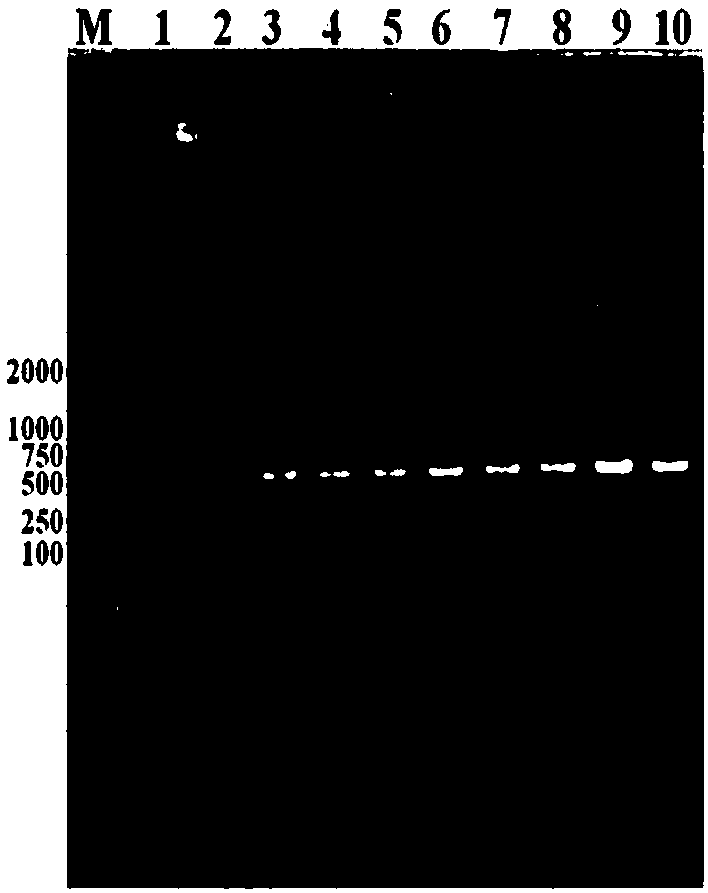Primer composition for assistant identification of porcine infectious pleuropneumonia ApxI toxin and application thereof
A primer composition and a technology of pleuropneumonia, applied in the biological field, can solve the problems of inability to provide accurate diagnosis and identification of antiviral factors, and achieve the effects of easy operation and application at the grassroots level, low cost and strong specificity
- Summary
- Abstract
- Description
- Claims
- Application Information
AI Technical Summary
Problems solved by technology
Method used
Image
Examples
Embodiment 1
[0056] The preparation of embodiment 1 primer composition
[0057] The primers shown in Table 1 were synthesized, and the nucleotide sequences of 1-F, 1-R, 2-F, and 2-R were shown in Table 1.
[0058] Table 1
[0059] Primer name
[0060] The partial gene sequence of ApxIA (Gene bank: AF 240779.1) is shown in sequence 5 of the sequence list (sequence length 513bp), and the primers are located in figure 1 , the partial gene sequence of ApxIVA (GenBank: FJ 848574.1) is shown in sequence 6 of the sequence table (sequence length 1092bp), and the primers are located in figure 2 .
Embodiment 2
[0061] Example 2 Primer Sensitivity Detection
[0062] Bacterial cultivation and DNA extraction
[0063] (1) Culture and DNA extraction of 1.5mL ApxⅠA standard bacteria and ApxIVA standard bacteria
[0064] Take 4 test tubes, add 7mL TSB, 5μl NAD, 300μl bovine serum, two of them add 50μl ApxIA standard bacteria solution, two of them add 50μl ApxIVA standard and mix well. Four test tubes were placed on a shaker at the same time, and incubated at 37°C for 12 hours at 200r / min.
[0065] Take 1.5mL ApxⅠA standard bacterial solution and ApxIVA standard bacterial solution respectively in two EP tubes, centrifuge at 12000r / min for 2min, and discard the supernatant. Repeat the operation twice. The DNA of the two bacteria was extracted according to the instructions of the DNA extraction kit. The DNA concentration of ApxⅣVA bacteria was measured to be 150 μg / mL; the DNA concentration of ApxⅠA bacteria was 240 μg / mL.
[0066] (2) Culture of other bacteria and extraction of DNA
[0...
Embodiment 3
[0075] The influence of embodiment 3 annealing temperature on PCR result
[0076] In the PCR reaction conditions, 6 different annealing temperatures were designed, namely 50°C, 52°C, 54°C, 56°C, 58°C, and 60°C. Using the reaction system in Table 2, the effects of different annealing temperatures on the PCR results of ApxIA and ApxIVA genes were determined. According to the results at different annealing temperatures, the effects of annealing temperature on the PCR reactions of toxins ApxIA and ApxIVA are different. Depend on Figure 5 It can be seen that the annealing temperature has a great influence on ApxIA. Although the target gene fragment can be obtained at all temperatures between 50°C and 60°C, the brightness of the bands at 50°C and 60°C is obviously not as bright as that at the intermediate temperature. bright. Depend on Figure 6 It can be seen that the change of annealing temperature between 50°C and 60°C has little effect on the ApxIVA fragment.
PUM
| Property | Measurement | Unit |
|---|---|---|
| concentration | aaaaa | aaaaa |
Abstract
Description
Claims
Application Information
 Login to View More
Login to View More - R&D
- Intellectual Property
- Life Sciences
- Materials
- Tech Scout
- Unparalleled Data Quality
- Higher Quality Content
- 60% Fewer Hallucinations
Browse by: Latest US Patents, China's latest patents, Technical Efficacy Thesaurus, Application Domain, Technology Topic, Popular Technical Reports.
© 2025 PatSnap. All rights reserved.Legal|Privacy policy|Modern Slavery Act Transparency Statement|Sitemap|About US| Contact US: help@patsnap.com



